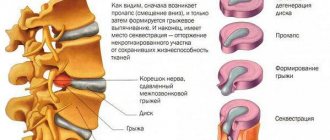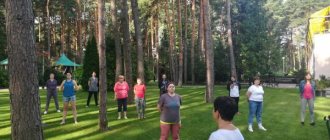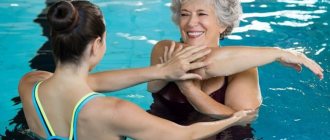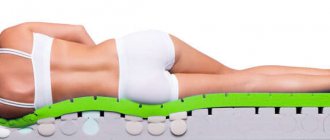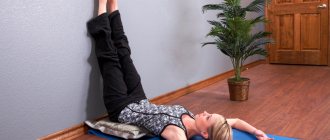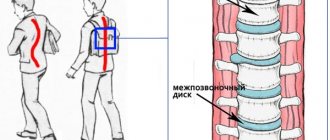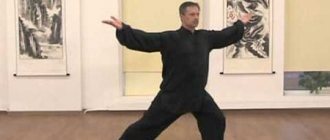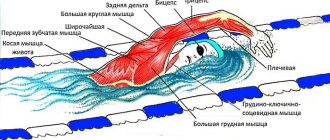Swimming is first and foremost fun! A little tired, but in high spirits, we return to the shore after even the shortest swim. A river or sea is not nearby every day, but a swimming pool can be found in any city, and, if possible, built in your own home.
Some people think that swimming has no effect on the body, because we get tired much less than, for example, when lifting weights or running. But this is not true at all. The load is felt weaker only because our body becomes lighter in water due to its density. However, when moving, a person has to overcome the resistance of water, which means that the muscles work more efficiently than on land.
And how grateful your cardiovascular system will be! In water, blood pressure decreases, so that with regular swimming, your health improves significantly.
The benefits of swimming in a pool for the spine are a separate topic for discussion. Let's take a closer look at how swimming affects the condition of the spine in various diseases.
How does therapeutic swimming help your back?
First of all, swimming relaxes the supporting muscles of the spine. At the same time, other muscles develop that should come to their aid - the abs, the trapezius muscle of the back. In water, all this happens smoothly, without unnecessary overloads and unwanted jerks. In addition, swimming improves endurance, coordination, and flexibility; normalization of the respiratory, cardiovascular systems and general strengthening of the body.
Why does my back hurt?
Back and lower back pain is a common problem faced by people of all ages - both adults and young people. The main causes of pain are:
- office “sedentary” work;
- slouch;
- osteochondrosis;
- herniated discs, etc.
Often pain and discomfort in the back are the result of high load on the spine. This can be explained simply: every day a person spends a lot of time in an upright position, which increases pressure on the intervertebral discs. The vertebrae become pinched, causing back pain. If you have any back pain, you should consult a specialist who will conduct an examination and select the right treatment. Most often in such cases, swimming is prescribed as an addition to the main treatment. Does your back hurt? Strengthen your back muscles by swimming!
Useful exercises in the pool for the back
During wellness procedures in the pool, the main thing is not to overload. It’s good if you use additional equipment - a swimming board, a calabashka, a ball.
When swimming on your stomach, you do not need to raise your head above the water. Only a smooth rotation of the neck to the sides, synchronized with the swings of the arms.
It is useful to perform the “Spiral” exercise, swimming and rotating at the same time from your back to your stomach, in one direction. But this is only in cases if you do not have any pain in the spine at the moment.
Swimming on the back is carried out with alternating circular swings of the arms far behind the head.
All this is done slowly, observing alternation of movements. 18 Mar 2021
Water aerobics for the spine: a set of exercises
First, you should consider a set of positions that allows you to statically and gently stretch and relax your back.
Only for this you will need to use delimiter floats, which are located between the tracks:
- with the thoracic spine lie on top of the floats, legs are extended freely, arms are extended behind the head, remain in this position, relax, sway calmly;
- lie down in the water between two strips of floats, so as to touch each one and be able to stretch a little between them, gradually perform a conscious tension of all the back muscles;
- the legs are thrown over the top of the side, the pelvis lies in the water and is pressed against the side of the side, the back is free in the water, they remain in this position until complete relaxation.
Next, more active exercises are performed , and this relaxation complex can also be used to complete the workout. Many of these exercises are performed in shallow water where it is comfortable.
If the disease has gone into remission, then you can do water aerobics, standing and jumping leg swings.- Squats in water.
- “Drawing” a circle with your feet in the water.
- “Drawing” “eights” with the pelvis.
- Punches in the water.
- Intensive crossing of straight legs, straight arms.
- Movement with straight arms up/down in the water.
- Raise your knees and pull them towards your chest, and straighten your legs.
- Exercise "bicycle" in the water column.
The number of repetitions should be chosen depending on the level of training. You should not get overly tired and overstrain your muscles; they will still receive significant tone from staying and moving in the water. A good option is to create your own set of movements that you like. After all, if they bring pleasure, then there is much more motivation to train in the future and the positive effect is better reinforced .
Safety first
It should be especially emphasized that the pool only helps those who follow safety rules. The fact is that, once in the water, a person suffering from osteochondrosis feels an instant decrease in pain, and he has a false sense of permissiveness. But any sudden or sweeping movement can further aggravate worn discs and pinched nerves. And this is fraught with a new exacerbation of the disease and a strong deterioration in the condition.
Security requirements can be formulated as follows:
- You need to perform the exercises very carefully, and in no case should you chase records;
- You can start exercising no earlier than 30 minutes after eating;
- you need to exercise either in a heated therapeutic pool, or in a pool where there is a specially designated and fenced area (this is necessary to prevent collisions with other swimmers);
- classes must be conducted by an instructor with special education; working out with an ordinary sports coach, or on your own, means dooming yourself to great risk;
- before entering the water (even if it is warm), you must complete a set of warm-up exercises;
- stay in the water should not exceed 45 minutes (longer swimming creates the danger of hypothermia and has a bad effect on the condition of the skin);
- After finishing classes, you need to take a contrast shower, perform relaxation exercises and drink hot or warm tea.
Important note. Even slight hypothermia obtained in water causes severe harm in osteochondrosis. If during exercise you feel that you are starting to feel cold, you must immediately get out of the water and warm up well.
Intervertebral hernia
If you are absolutely healthy, swimming will contribute to the overall strengthening of the muscles of the whole body. In the case of such an unpleasant and dangerous disease as intervertebral hernia, the load received in the pool will strengthen the muscle corset. This will reduce pain, because the muscles will better support the sore spot. In addition, swimming improves blood circulation, which is extremely important for improving your condition. The only thing you need to remember is that excessive stress on a sore back is strictly prohibited, so you should swim on your back.
What if you go on a hike?
Even if the main purpose of your trip is the sea, you are unlikely to spend your entire vacation on the beach. You will probably want to explore the local attractions or even go on a hike. People with spinal problems should do the latter only lightly - multi-kilogram backpacks are not for you. But even if the walk is relaxed and pleasant, be sure to take care of comfortable shoes - low, wide heels with elastic, soft soles.
It will “dampen” the impact of the foot on the ground, and the vibration from it will not be transmitted to the spine (it is harmful - it contributes to the appearance of microtraumas).
Why is swimming recommended for osteochondrosis?
Swimming brings significant relief for osteochondrosis of any part of the spine. As soon as a person is immersed in water, his body becomes practically weightless, the muscles relax as much as possible, and the pressure compressing the vertebrae disappears. Under such conditions, the distance between the vertebrae immediately becomes greater, and this allows the deformed discs to straighten out and begin to restore their natural shape.
When the intervertebral spaces expand, the pinched nerve endings are released and the pain subsides. The increase in these intervals is so significant that after a 45-minute swimming lesson, a person’s height increases by almost a whole centimeter. But after a person leaves the water, the intervertebral discs compress again, and growth becomes the same.
The vast majority of people suffering from osteochondrosis feel immediate relief when completely immersed in an aquatic environment.
But for a cure, or at least to curb the disease, simply visiting the pool is completely insufficient. To restore the health of your spine, you must follow the rules of behavior in the pool.
Contraindications for swimming
Swimming for the purpose of health has no restrictions on age and level of training, but there are certain contraindications for health reasons:
- serious pathologies of the cardiopulmonary system;
- skin diseases - eczema, dermatitis and others;
- viral and bacterial infections;
- exacerbation of osteochondrosis, sciatica;
- any disorders of the central nervous system.
Before you sign up for the pool, you need to be examined and consult with your doctor to avoid negative health consequences.
Before visiting the pool, you should visit a therapist
As for the inability to swim, this is not at all an obstacle to training: with the help of specialists, you can quickly learn how to float on the water and master basic techniques. In addition, there are special sets of exercises in water, for which you do not need to be able to swim. They may be slightly less effective than swimming, but still give better results than exercise on land.
Health-improving gymnastics
The benefits of hanging on a horizontal bar for any form of osteochondrosis have been clinically proven. The spinal column is stretched, the distance between the discs and vertebrae increases, and pinched nerves are released. But such training is beyond the power of old people, overweight people, and weakened patients. Exercise therapy pools are equipped with special crossbars. By holding on to them and immersing your body in the water, you can not only hang for a long time, but also perform certain movements.
If you have the opportunity to perform the movements recommended by your doctor after regular swimming, you should definitely take advantage of it. Here are the most common and effective exercises to strengthen the spine:
- lower yourself into the water, raise your knees, simulating walking in place. After a few minutes, start moving in the water, gradually increasing the pace;
- standing in the water, alternately pull your knees towards your body, spreading your arms to the sides. During training, the main load should fall on the legs, and not on the spine;
- lie on your stomach, holding the side, spread and close your straight legs, performing a “scissors” movement;
- squat to the maximum possible depth. At the beginning of training, you can maintain your balance by holding onto the side;
- float on an inflatable raft, moving by not too intense swings of your legs. For cervical osteochondrosis, it is enough to swim 25-30 m, for lumbar osteochondrosis - 50-100 m;
- Hold an inflatable raft or pillow between your legs and swim, making strokes only with your hands. If you experience pain in the lumbar region, you do not need to perform the exercise.
During training, it is important not to overload the cervical spine. The load should be evenly distributed over the entire spine, lower and upper limbs. We should not forget the useful pressure difference at the interface between air and water. Exercises for cervical osteochondrosis are performed while diving to the collarbones. For chest pathology, you need to go into the water up to your chest, for lumbosacral pathology - up to your waist.
The training ends with free swimming for 10-15 minutes. Then you need to take a shower, dry yourself and be sure to lie down on the couch for half an hour to restore your breathing and relax.
What accessories can you use when swimming if you have back pain?
Advice from Proswim experts: use swimming accessories - boards, sticks, swimming paddles - to increase the productivity of your workout, as well as for the prevention and treatment of back diseases. What accessories can be used for back pain?
- swimming board . This accessory completely isolates the work of the arms, thus training only the muscles of the core and legs. Swimming with a board helps stabilize your body position in the water. The spine is stretched, which has a beneficial effect on joint mobility. The swimboard is suitable for all swimming styles. The accessory should be held on outstretched arms, while the face looks down at the bottom of the pool. At the same time, the body is stretched out like a string. With this position of the body in the water, the load is distributed evenly.
– the kolobaska allows you to isolate the work of the legs and focus on training the upper body. The kolobaska is fixed between the thighs - this makes it easier for the swimmer to keep his back correctly.
– Swimming paddles help reduce the load on the shoulder girdle and back muscles. By practicing swimming in a pool with paddles, you improve the correct stroke technique and put the right load on your back muscles, reducing the risk of various injuries.
